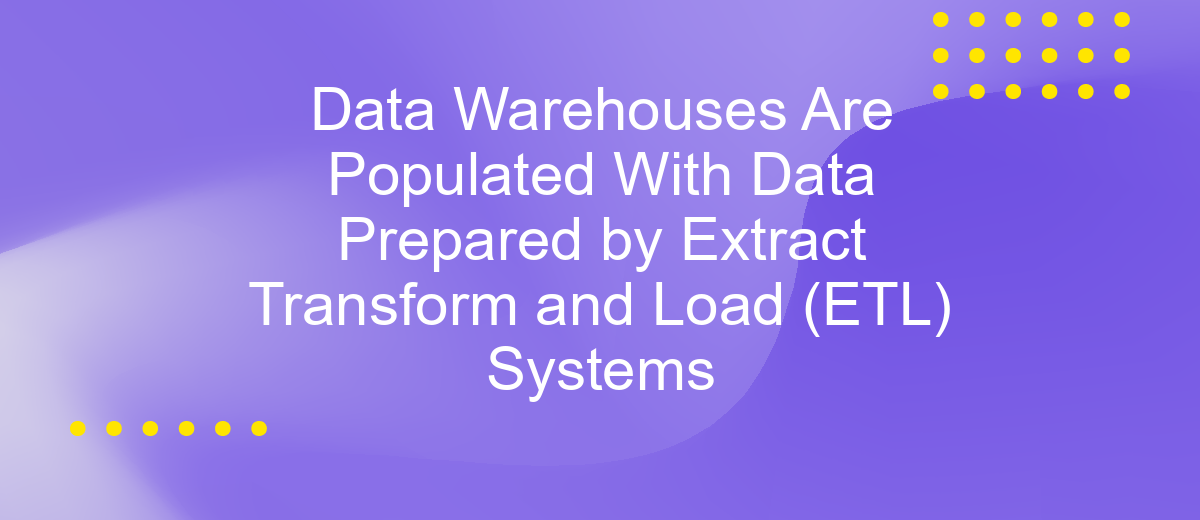Data Warehouses Are Populated With Data Prepared by Extract Transform and Load (ETL) Systems
Data warehouses serve as centralized repositories for large volumes of data, enabling businesses to perform comprehensive analysis and reporting. A critical component in populating these warehouses is the Extract, Transform, and Load (ETL) process. ETL systems efficiently extract data from various sources, transform it into a suitable format, and load it into the warehouse, ensuring data consistency and quality.
Introduction
Data warehouses play a crucial role in modern data management by serving as centralized repositories for vast amounts of information. These warehouses are populated with data that has been meticulously prepared through Extract, Transform, and Load (ETL) systems. ETL processes ensure that data is extracted from various sources, transformed into a suitable format, and loaded into the warehouse for analysis and reporting.
- Extraction: Gathering data from multiple, often disparate sources.
- Transformation: Converting data into a consistent format suitable for analysis.
- Loading: Inserting the transformed data into the data warehouse.
Efficient ETL processes are critical for maintaining the integrity and usability of data within a warehouse. Services like ApiX-Drive can simplify the integration of various data sources, automating the ETL workflow and ensuring seamless data transfer. With the right tools and strategies, organizations can leverage their data warehouses to gain actionable insights and drive informed decision-making.
Data Extraction

Data extraction is the initial phase of the ETL process, where raw data is collected from various sources. This data can originate from transactional databases, APIs, flat files, or even web scraping. The goal is to gather all relevant data, ensuring it is accurate and complete for subsequent transformation and loading. Effective extraction requires a deep understanding of the source systems and the ability to handle different data formats and structures.
Modern tools and services, such as ApiX-Drive, simplify the extraction process by providing seamless integrations with numerous data sources. ApiX-Drive allows users to set up automated data extraction workflows without requiring extensive coding knowledge. By leveraging such services, organizations can streamline their data pipeline, reduce manual intervention, and ensure timely and consistent data availability for further processing in the data warehouse.
Data Transformation

Data transformation is a crucial step in the ETL process, involving the conversion of raw data into a format suitable for analysis. This process ensures that data from various sources is standardized, cleansed, and enriched to meet the specific needs of a data warehouse. The goal is to enhance data quality and consistency, making it more useful for business intelligence and decision-making.
- Data Cleaning: Removing inaccuracies and inconsistencies from the data.
- Data Standardization: Converting data into a common format or structure.
- Data Enrichment: Adding valuable information to the existing data sets.
- Data Aggregation: Summarizing data for easier analysis.
- Data Validation: Ensuring the transformed data meets all required standards and rules.
Tools like ApiX-Drive can significantly simplify the data transformation process. ApiX-Drive offers seamless integration capabilities, allowing users to connect various data sources and automate the transformation tasks. By leveraging such tools, organizations can ensure that their data is consistently prepared and ready for analysis, ultimately enhancing the efficiency and accuracy of their ETL workflows.
Data Loading

Data loading is a critical phase in the ETL process where transformed data is transferred into the data warehouse for storage and subsequent analysis. This step ensures that data is accurately and efficiently loaded, maintaining the integrity and consistency of the information.
The process of data loading can be complex and requires careful planning and execution. It involves various strategies and techniques to handle different types of data and their respective volumes. The goal is to minimize downtime and ensure that the data warehouse remains available for querying and reporting.
- Incremental Loading: Only new or updated data is loaded, reducing the load time and resource consumption.
- Full Load: All data is loaded from the source system, often used during initial setup or major updates.
- Batch Loading: Data is loaded in batches at scheduled intervals, balancing load and performance.
- Real-time Loading: Data is loaded as soon as it is available, providing up-to-date information for real-time analytics.
Services like ApiX-Drive facilitate seamless integration and automation of data loading processes. By connecting various data sources and automating the ETL workflow, ApiX-Drive ensures that data is consistently and accurately loaded into the data warehouse, enhancing efficiency and reliability.
- Automate the work of an online store or landing
- Empower through integration
- Don't spend money on programmers and integrators
- Save time by automating routine tasks
Benefits of ETL Systems
ETL systems offer numerous benefits that significantly enhance data management and analytics capabilities for organizations. By automating the process of extracting, transforming, and loading data, ETL systems ensure data consistency and accuracy across various sources. This automation reduces the likelihood of human error and speeds up data processing, enabling businesses to make timely and informed decisions. Furthermore, ETL systems facilitate the integration of diverse data sets, providing a unified view of information that supports comprehensive analysis and reporting.
Another key advantage of ETL systems is their scalability and flexibility. As organizations grow and their data needs evolve, ETL systems can easily adapt to handle increasing volumes of data and more complex transformations. Tools like ApiX-Drive simplify the integration process by offering user-friendly interfaces and pre-built connectors for various data sources, reducing the technical burden on IT teams. This enables businesses to quickly set up and modify data pipelines, ensuring that their data infrastructure remains agile and responsive to changing requirements.
FAQ
What is ETL in the context of data warehousing?
Why is ETL important for data warehousing?
Can ETL processes be automated?
What are the common challenges faced during ETL implementation?
How often should ETL processes run?
Strive to take your business to the next level, achieve your goals faster and more efficiently? Apix-Drive is your reliable assistant for these tasks. An online service and application connector will help you automate key business processes and get rid of the routine. You and your employees will free up time for important core tasks. Try Apix-Drive features for free to see the effectiveness of the online connector for yourself.


